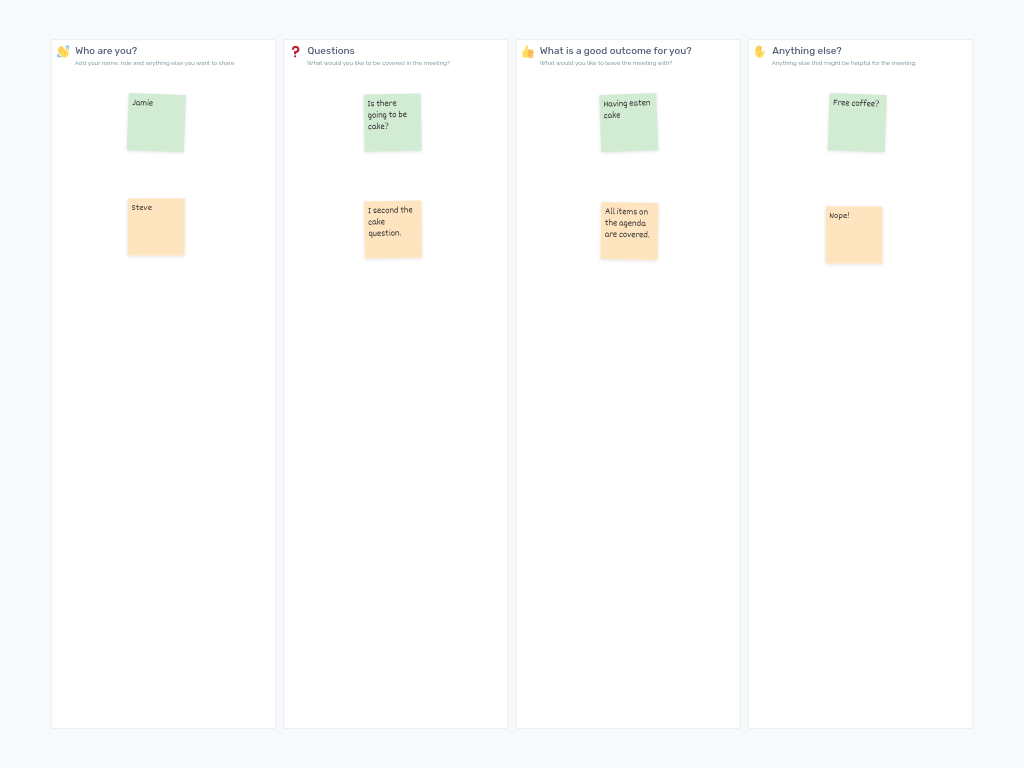Definition of Done (DoD) Template
A Definition of Done workshop helps agile development teams establish clear completion criteria for their work. By collaboratively defining what "done" truly means, teams can eliminate ambiguity, improve quality, and create consistency across all deliverables in their sprints and projects.
What Is a Definition of Done?
A Definition of Done (DoD) is a comprehensive checklist of requirements that must be fulfilled before a user story, feature, or product increment can be considered complete. Unlike acceptance criteria (which are specific to individual stories), the DoD applies universally to all work items and represents a shared understanding of quality standards within the team.
The DoD creates transparency by making implicit expectations explicit, helping teams consistently deliver high-quality work that meets all technical, functional, and organizational requirements. It serves as a quality gate that prevents incomplete work from moving forward in your development process.
Benefits & When to Use
Benefits of a clear DoD:
- Reduces technical debt by ensuring all necessary quality steps are completed
- Creates shared understanding and expectations across the entire team
- Improves estimation accuracy by accounting for all required work
- Minimizes rework and "almost done" scenarios that derail sprint progress
- Enhances transparency with stakeholders about completion criteria
When to use this template:
- At project kickoff to establish initial quality standards
- During team formation to align on working practices
- Before sprint planning to ensure proper scoping
- During retrospectives to refine and improve your definition
- When onboarding new team members to convey quality expectations
How to Run a Definition of Done Workshop
Time needed: 60-75 minutes
Introduction (5 minutes)
- Explain the purpose of a DoD and how it differs from acceptance criteria
- Share that the DoD will be a living document that evolves with the team
Brainstorm Completion Criteria (15 minutes)
- Ask: "What makes a story truly done in our context?"
- Have everyone create individual sticky notes for each requirement or activity
- Include both current practices and aspirational ones
- Examples: code reviewed, acceptance tests automated, documentation updated
Group Similar Items (10 minutes)
- Organize sticky notes into logical categories
- Eliminate duplicates and refine wording for clarity
- Typical groupings might include coding, testing, documentation, and deployment
Prioritize and Select (15 minutes)
- Use voting to identify the most important criteria
- Discuss what's realistic vs. aspirational
- Consider the balance between quality and speed
Create a Timeline (15 minutes)
- Arrange the selected criteria in chronological order
- Define clear stages in your development process (e.g., Scoping, Development, Testing, Release)
- For each stage, determine who's responsible and how completion is measured
Finalize Your DoD Document (10 minutes)
- Capture the agreed-upon criteria in the provided template
- Make sure each item is specific, measurable, and actionable
- Transfer the final DoD to your team's documentation space
Plan for Review (5 minutes)
- Agree on when and how often to review and refine the DoD (typically during retrospectives)
- Discuss how to share the DoD with new team members
Tips for a Successful Definition of Done
- Keep it visible: Make your DoD accessible in your team's digital workspace, not buried in documentation.
- Be realistic: Start with essential quality standards and gradually add more as the team matures.
- Make it actionable: Each item should be clearly verifiable – avoid vague criteria like "well-tested."
- Consider different perspectives: Include criteria from testing, UX, operations, and security – not just development.
- Evolve it: Review your DoD regularly and adjust based on changes in your team's capabilities or project needs.
- Use it actively: Reference the DoD during planning, standups, and reviews to reinforce its importance.
- Distinguish from acceptance criteria: Help the team understand that DoD is universal while acceptance criteria are story-specific.
A well-crafted Definition of Done transforms quality from an aspiration to a consistent practice. When teams know exactly what "done" looks like, they can deliver more predictably and spend less time debating completion status.



